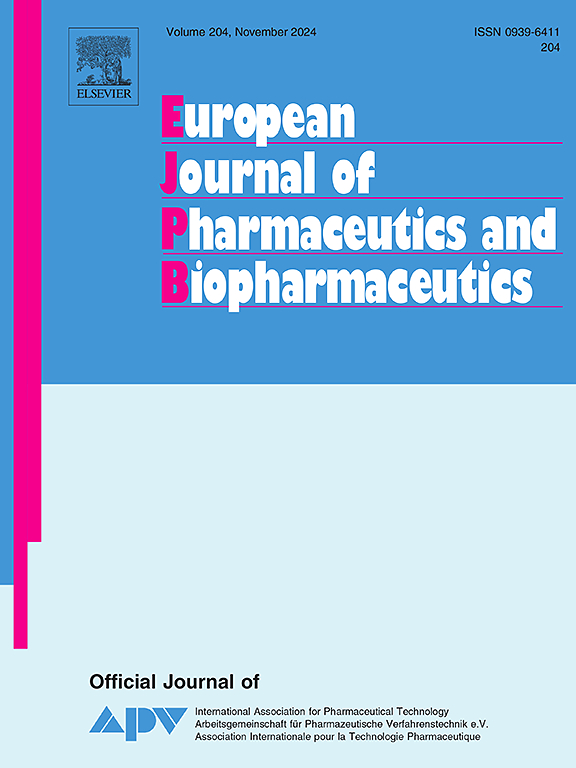有机酸反离子在调节普鲁卡因盐的体外溶出和渗透性中的作用
IF 4.3
2区 医学
Q1 PHARMACOLOGY & PHARMACY
European Journal of Pharmaceutics and Biopharmaceutics
Pub Date : 2025-05-26
DOI:10.1016/j.ejpb.2025.114758
引用次数: 0
摘要
普鲁卡因是一种广泛使用的局部麻醉剂,起效缓慢,可迅速降解为对氨基苯甲酸和二乙胺乙醇,因此半衰期短,作用时间短。在这项研究中,我们研究了盐化,以改变溶解速度和渗透率,而不改变化学结构或使用复杂的配方。制备了6种含羧酸的普鲁卡因盐和4种含磺酸的普鲁卡因盐,并与盐酸普鲁卡因盐进行了系统评价,重点研究了它们在pH 4.5和7.4两种生理条件下的体外药动学特性。溶出率研究表明,所有普鲁卡因盐在30分钟内完全溶解,而普鲁卡因溶解率达到75%,即使在2小时后仍部分不溶解。此外,渗透性研究揭示了不同普鲁卡因盐之间的渗透值范围,其中磺酸阴离子显著提高了普鲁卡因的渗透率,约为40%至70%。此外,还评估了渗透性和亲脂性描述符之间的相关性,特别注意离子对稳定性、反离子的亲脂性和中性形式的普鲁卡因的亲脂性。值得注意的是,渗透性较高的盐,主要是磺酸盐,表现出更不稳定的离子对,有助于更有效的药物扩散,并可能更快地起效和吸收普鲁卡因。另一方面,羧酸倾向于赋予更高的离子对稳定性,抑制膜渗透。我们的研究结果支持被动渗透的典型模型,表明药物的中性形式可以在膜附近或跨膜室内响应局部环境条件而形成。在这种情况下,中性形式和离子对都可以作为跨膜分配平衡的一部分作出贡献并发挥作用。本文章由计算机程序翻译,如有差异,请以英文原文为准。

The role of organic acid counterions in modulating the in-vitro dissolution and permeability profiles of procaine salts
Procaine, a widely used local anesthetic, suffers from slow onset and rapid degradation into para-aminobenzoic acid and diethylaminoethanol, resulting in a brief half-life and short duration of action. In this study, we investigate salification in order to modify dissolution rate and permeability without altering the chemical structure or using complex formulations. Six procaine salts with carboxylic acids and four with sulfonic acids were prepared and systematically evaluated in comparison with procaine hydrochloride, focusing on their in-vitro pharmacokinetic properties in two physiological conditions at pH 4.5 and 7.4. Dissolution rate studies showed that all procaine salts achieved complete dissolution within 30 min, while procaine reached 75 % dissolution and remained partially undissolved even after 2 h. In addition, permeability studies revealed a range of permeation values among the different procaine salts, in which sulfonate anions significantly improved the permeability of procaine by approximately 40 % to 70 %. Furthermore, a correlation between permeability and lipophilicity descriptors was assessed, with particular attention to ion pair stability, the lipophilicity of the counterion and the lipophilicity of procaine in its neutral form. Notably, salts with higher permeability, primarily sulfonates, exhibited less stable ion pairs, contributing to a more effective drug diffusion and a potential for faster onset and absorption of procaine. On the other side, carboxylic acids tend to confer a higher ion pair stability, inhibiting the membrane permeation. Our findings support the canonical model of passive permeability, suggesting that the neutral form of the drug can form in response to local environmental conditions near the membrane or within the transmembrane compartment. In this context, both the neutral form and the ion pair could contribute and play a role as a part of the equilibrium of partitioning across the membrane.
求助全文
通过发布文献求助,成功后即可免费获取论文全文。
去求助
来源期刊
CiteScore
8.80
自引率
4.10%
发文量
211
审稿时长
36 days
期刊介绍:
The European Journal of Pharmaceutics and Biopharmaceutics provides a medium for the publication of novel, innovative and hypothesis-driven research from the areas of Pharmaceutics and Biopharmaceutics.
Topics covered include for example:
Design and development of drug delivery systems for pharmaceuticals and biopharmaceuticals (small molecules, proteins, nucleic acids)
Aspects of manufacturing process design
Biomedical aspects of drug product design
Strategies and formulations for controlled drug transport across biological barriers
Physicochemical aspects of drug product development
Novel excipients for drug product design
Drug delivery and controlled release systems for systemic and local applications
Nanomaterials for therapeutic and diagnostic purposes
Advanced therapy medicinal products
Medical devices supporting a distinct pharmacological effect.

 求助内容:
求助内容: 应助结果提醒方式:
应助结果提醒方式:


